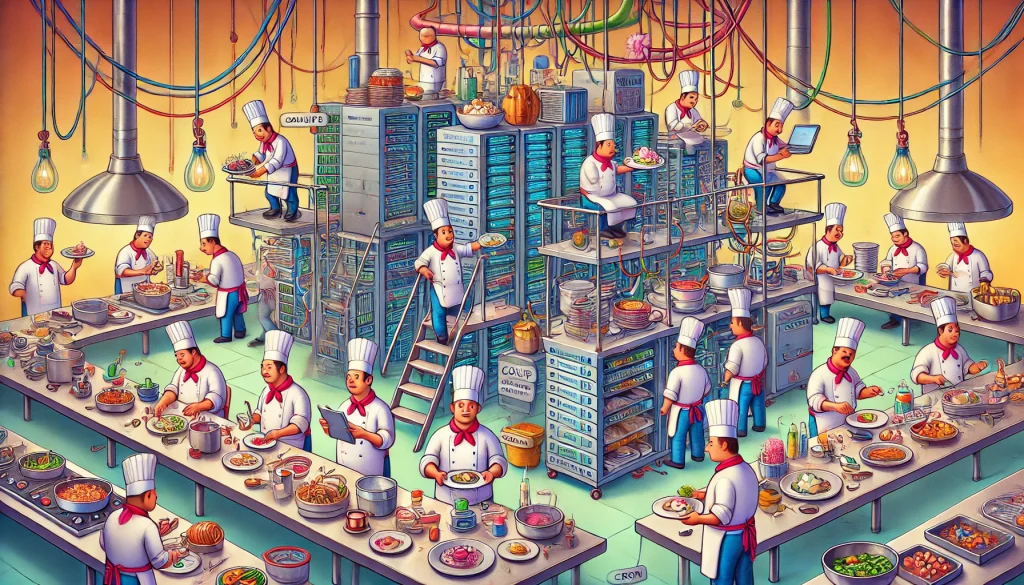System Design – What’s the Big Deal?
Introduction
Let’s ask ourselves a simple question: What do we want from a system?
At its core, it’s like this – when you ask for something, the server should politely (and quickly) respond, like a waiter in your favorite restaurant. The client worries about their own setup, but as the server, it’s your job to keep the kitchen running smoothly.
Business Requirements – Always Hungry!
Your system will face a ton of demands, sometimes too much for your trusty little server to handle. You’ll hit a point where it feels like your server is shouting – Brother, don’t send more requests! That’s when you start thinking about upgrading.
Here are your two options:
- Bigger and better machines – This is called vertical scaling (or “let’s buy the fanciest oven!”).
- More machines – Enter horizontal scaling (think “hire more chefs!”).
But scaling isn’t just about throwing money at machines. There are a few things you need to handle:
- Load Balancing: Share the workload evenly among your machines. Nobody likes that one overworked chef sweating buckets. Use AI tools to simulate workloads and identify bottlenecks before they happen. It’s like a crystal ball for your servers.
- System Failures: Because no matter how good your machines are, Murphy’s Law exists. Train an AI to predict failures based on historical data. It’s your “server astrologer”!
- Machine Chit-Chat (Intercommunication): Your servers need to gossip efficiently for smooth operations. Deploy AI models to optimize communication patterns and reduce latency. AI knows how to “talk” better than us!
- Data Consistency: Ensure everyone is on the same page (or the same data version). Use AI for real-time data sync and consistency checks. It’s like having a vigilant accountant in your system.
- Hardware Limits: Even the fanciest machine has its limits. AI can analyze performance trends and recommend when to scale up or out, so you don’t overspend.
Most of the time, you’ll need a hybrid approach – take the best of both scaling methods. After all, isn’t jugaad (creative problem-solving) in our DNA?
Let’s Cook Up a System Design – Restaurant Edition 🍴

When your restaurant turns into a tech startup: Chefs juggling tasks, AI assistants buzzing around, and a dash of chaos for good measure!
Imagine you’re opening a restaurant. How would you design it? Here’s how it maps to system design:
- One Superstar Chef: You hire one amazing chef who handles everything. But as orders increase, you start paying them more and optimizing their workflow. This is like having one server and scaling vertically. Use AI to track chef performance (or server metrics) and suggest optimizations. It’s like a personal trainer for your chef.
- Backup Chef: Your main chef falls sick one day (God forbid), so you call in a backup. This is your backup server. AI can monitor system health and automatically spin up backups when needed. No manual interventions are required.
- Stock Up in Off-Peak Hours: Prepare your ingredients during slow times. This is cron jobs in action. Let AI decide the best times to run these tasks based on usage patterns. Smarter than a clock!
- Specialist Chefs: One chef excels in biryani, another in dosas. Route specific orders to the experts. This is a microservices architecture. AI can help route requests dynamically to the best-fit server (or chef). No human guesswork is needed.
- Open New Branches: Power cuts or local lockdowns? Open restaurants in other areas to keep serving customers. This is distributed servers. AI can decide which locations need more resources based on demand predictions. It’s a restaurant expansion guru!
- Central Command: You need someone (or something) to manage orders across branches. Welcome to distributed systems. Deploy AI to coordinate between branches (or servers) seamlessly. It’s like your super-smart restaurant manager.
- Reuse Resources: Your delivery guy doesn’t care whether he’s carrying butter chicken or paneer tikka. He just delivers it. That’s code reuse! AI can suggest reusable code snippets, saving time and effort for your dev team.
Web Portal for the Restaurant
Designing a serverless system for a restaurant’s web portal is like running a kitchen without full-time chefs (servers). Tasks are done on demand. Similarly, using tools like AWS Lambda, Azure Functions, or Google Cloud Functions, the system can easily handle scaling.
For example, when a customer places an order, serverless functions process it (like cooking on demand), and a managed database like DynamoDB stores customer data. The cloud service provider handles load balancing, while tasks like sending confirmation emails or updating inventory are managed by event-driven functions (cron jobs). AI can analyze traffic, optimize triggers, and predict peak times. This setup is cost-effective since you pay only for what you use, making it ideal for handling unpredictable traffic while ensuring a smooth customer experience.
High-Level Design vs. Low-Level Design
Once you’ve nailed your high-level design (what your restaurant will look like), it’s time for low-level design—the nitty-gritty of cooking and serving. Think about it: recipes, timing, plating. In coding terms, this is the actual development work.
GenAI Hack: For low-level design, use AI-powered code generators or suggestions to speed up development. It’s like having a sous chef for your coding kitchen.
A Recipe for Success
Here’s your takeaway:
- Too Many Orders? Hire more people.
- Complex Menu? Separate responsibilities.
- Unexpected Mishaps? Have backups and plans in place.
- Want a GenAI touch? From predicting failures to optimizing workflows, GenAI is your new best friend in system design.
System design is all about planning for scale, speed, and stability. Just like running a restaurant, it’s not easy, but it’s definitely rewarding. So, roll up your sleeves, get your hands dirty, and happy designing!

